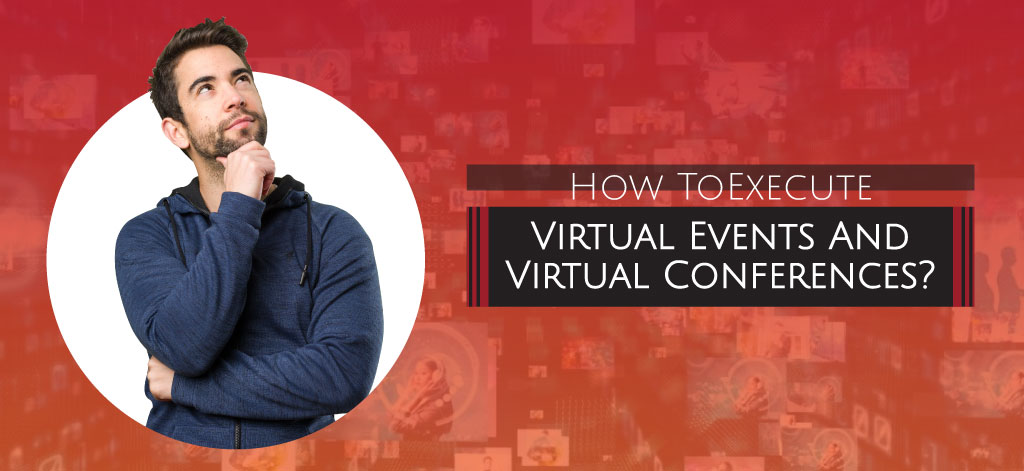At a time when most of the world is under lockdowns, quarantines or movement restrictions due to the ongoing COVID-19 pandemic, virtual events and video conferences have once again taken the front seat.
With most companies and industries shut down indefinitely, and workers confined to their homes, remote conferencing and communication is the only viable option left for businesses around the world.
However, this virtual shift in the scenario comes with its own set of limitations and setbacks. For one, it hampers easy flowing communication between teams stranded in different places. And another, it affects your communication with your clients. When this inter-team and company-client communication is disrupted, the productivity and the market value of the entire organization suffers.
Virtual meeting platforms have really brought out a solution to this hard-pressing problem, by enabling scores of people to communicate effectively using just a working high-speed internet connection and a handheld or mounted internet-enabled device.
However, as they say, no matter what or how bad the outside situation is, business must go on. For business owners who run huge international supply chains and service millions of customers worldwide, keeping the work flowing even during this shutdown is absolutely essential.
Virtual Event Solutions for Businesses
Virtual events solutions have given businesses a much required helping hand with stabilising communication channels, conducting remote virtual conferences and virtual summits with their clients, and helping team members at various locations connect with each other better.
Live events have now become a need for businesses looking to maintain their foothold in the events industry even with the current quarantine situation.
To oversee the workflow and maintain task normalcy of operations, as well as to carry on effective communication with the clients, many organizations have employed remote meeting technology to ensure proper communication.
Not to mention, virtual events also increase audience engagement and user outreach, and are perfect tools for brands looking to tap into new, previously undiscovered markets.
While virtual conferences help brands keep their communication channels with their clients open and progressive.
Considering the current pandemic, where conducting large-scale physical events and holding regular face-to-face meetings with clients is almost impossible, brands should quickly shift focus to converting these physical events into virtual events, and make the best use of virtual conference solutions.
If you’re new to all the Virtual events, virtual summits, conferences and virtual meetings fiasco, you might want to stay with us for a little while longer, as we explain the basics of Virtual meetings platforms and how to carry out a virtual event or a virtual summit successfully. Read on to know more.
What are Virtual Events and Virtual Conferences?

Virtual Events and Virtual Conferences or virtual summits are remote technology meetings solutions that let people attend meetings or events taking place at a remote location while sitting at their homes. People can attend these virtual meetings through their laptops, desktops and mobile phones with a working Internet connection.
These summits or meetings are facilitated by virtual summit platform or we say it a virtual meeting platform , of which there are multiple kinds with specific features.
These virtual conferences are hosted over the internet using remote meeting technology solutions. Some of the most well-known examples of virtual events and video conferencing apps are Google Duo, Google Hangouts, Skype, Zoom etc.
These apps help businesses conduct virtual conferences and virtual events through which they attempt to encourage swift and effective communication with clients and also within members to oversee and organize tasks. Virtual events solutions are extremely effective during crisis situations like the current one we’re facing. They help corporations conduct B2B meetings with clients and stakeholders across the globe effectively. Virtual Conferences can also really help organizations get their work back on track and lift employee morale across sectors.
How to Conduct a Successful Virtual Event through Virtual Conference Apps?

In order for businesses to conduct successful virtual events, virtual summits and virtual conferences, they have to follow a step-by-step process that includes planning and preparation, setting goals, creating an action plan, setting up the virtual meeting, event, summit or conference and docking challenges.
Below, we give a step-by-step breakthrough of the process required. Have a read.
Create an All-Inclusive Plan for Your Virtual Conference and Virtual Events

This step requires you to define your objectives regarding conducting virtual meet. It is important to identify and narrow down the virtual meetings or virtual summit platforms and the remote meeting technologies you will use, and to plan to evade any potential obstacles in the process.
You also need to create a plan that includes your audience demographics for the virtual event and figures out ways to rope them in.
Optimizing your virtual summit or virtual conference for mobile devices should also be a part of your game plan, as most of your audience, clients and workforce will inevitably want to participate in the event or meeting through their mobile devices, owing to their versatility and ease of use.
Define a Timeline for Your Virtual Event or Virtual Conference

The next step is to define a clear timeline for your virtual event or virtual conference, depending on the people attending, their time zones and other operational logistics.
Single out the specific tasks that needs to complete in order to carry out virtual event successfully, and set timelines.
Note however, that the timelines need not just be for the virtual event or conference itself, but also includes pre-event preparations and post-event analytical activities.
While setting timelines, you also need to fold in your management and operations team in the decision process. And if you’re conducting a B2B virtual conference with your clients, you need to get a go-ahead from them too. If deadlines are last minute, then ensure that the tasks and responsibilities, are effectively conveyed to clients and back-end teams. Ensure that no confusion prevails in the entire process of conducting the virtual event or virtual conference.
Plan and Deploy Your Resources

Events are almost always a huge management challenge, and when they’re being carried out online, the challenge manifolds.
Even though virtual events solutions step in to save you from effective doom, the reins of success largely lie in your hands and brains!
One of the most crucial parts of event planning and preparation is resource planning and responsibility allocation. Put in simpler, layman terms, it means you need to effectively analyze your team members individually, and chart different responsibilities for them to perform in the virtual event.
Once you have chalked up individual responsibilities, it’s crucial to have a clear, one-on-one communication with the team in order to make them understand their responsibilities and chart out their plans.
When it comes to conducting a B2B two way video conference with your clients and stakeholders, you need to ensure that your communication points are clear, your operational functioning is optimal and that you plan each minute of the virtual conference effectively.
Virtual summit platforms or virtual meeting platforms can really help you with these aspects of event planning, and you, your clients and your team can take it from there.
Consider Static Technical Requirements

Conducting virtual events, virtual summits or virtual conferences is no easy feat, as any event manager who has ever been a part of a virtual event can tell you.
It requires seamless coordination among, not just the human resources, but also technical resources.
To carry out a successful virtual event or virtual conference, you need a strong, lag-free internet connection, hardware and software encoders plus application systems to maintain data privacy and protect against any potential cybersecurity threats on any virtual events platform or remote meeting technology platform.
An ideal solution would be to set realistic deadlines. It is important to give yourselves and your back-end teams enough time to procure necessary resources, and run a pre-test to deduct just how well the virtual event or virtual conference will go in real-time situations, with real audience and stakeholders.
Again, remote meeting technology can play a huge role in solidifying your inter-team cooperation and maintaining effective communication.
Market Your Virtual Event Strategically

You are conducting the virtual event or virtual summit to gather more and more views, user engagement and outreach. Keeping this goal clear in your head, you should devise strategies and plans to effectively market your virtual event to the aspired audience demographic.
Thankfully, we have social media platforms to save the day when it comes to marketing virtual events to users in different countries and timezones.
Social Media platforms, with their wide reach and huge user base in nearly all countries, can offer you profound help in optimizing your virtual event marketing efforts and give you an insightful outlook on your audience demographics.
You can safely try the following tried and tested marketing strategies for your virtual event:
- Email marketing
- Blog marketing
- Social Media marketing
- Listing your virtual event on popular event sites
- Paid marketing through social media
Note that, most virtual events platforms come with their own unique marketing features that allow users to effectively market their virtual events to potential audiences worldwide.
Send Reminders to People Who Sign Up or Show Interest

Much like YouTube/Netflix reminders, set a system that send reminders to those who have shown interest in attending your event. In the case of a B2B virtual conference, give out reminders to your clients all over the world and team members to be present with their laptops or mobile devices at the mentioned time.
Engage with Your Audience and Stakeholders

Once tuned in, ensure to engage with your audience as much as you can through the virtual event platform itself. Many virtual events solutions provide you the facility to answer comments from your audience. Engage with them one-on-one and provide them with a personalized sticker after the end of the event.
This is quite similar to how brands give out hashtag photos to their guests at events using the hashtag printer. The only difference is that since the event is virtual, the stickers are also virtual!
The more you engage with your audience, the more they’ll feel like they’re truly a part of your virtual event. If there’s one upside to being in quarantines, it’s that you have an upper hand on all the other businesses that so far relied too much on physical events and in-person interaction. With the world going virtual, it’s truly your time to shine!
In B2B virtual conference with clients and stakeholders, you must be attentive and answer their queries with relevant, credible information.
Remember that the economic situation is bound to get worse before it gets better, so investing in good, lasting client relationships is sure to win you massive benefits in the long run.
Save Digital Records of a Virtual Conference Presentation

Given how virtual conferences work, it’s quite possible that some of your clients and stakeholders might be unable to access the virtual meeting platform to attend the virtual conference.
In such cases, it’s best to have a digital copy of the presentation you gave in the virtual meeting. Keep it handy to provide them later, for their reference and future points of concern.
Make Flawless and Well-Informed Landing Pages for Your Audience and Expected Clients to Find Out About Your Brand

So you carried out an exceptionally well virtual event or virtual summits, or did a wonderful job at convincing a client to join operations with you at a B2B virtual conference, but your task doesn’t end here. After a successful virtual event , most of your audience are likely to want to know more about your brand.
Ensure these new audiences and prospective clients learn about your brand in the best possible manner. To know this, you need to make an engaging, interactive and well-designed landing page. Embed this landing page at the end of your virtual event or virtual conference so that users can give their feedback.
The better designed and informative your landing page is, the more you get new customers and impress new clients from your virtual event/conference.
Carrying out virtual events and virtual conferences during these times, especially when you’ve never done it before, can prove to be stressful and daunting. This is where live streaming agencies can come in to help you. With an extensive portfolio of having helmed live-streaming operations of some major brands across the globe, Dreamcast is one such live streaming and virtual event agency which is poised to help you navigate B2B virtual conferences, virtual summits and virtual events during this quarantine period.
Get all the help needed with conducting virtual events, B2B virtual conferencing, virtual AGMs and virtual summits, virtual meetings and more with us!



















